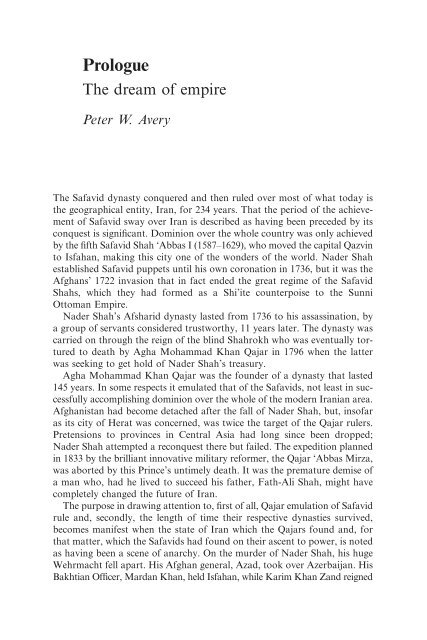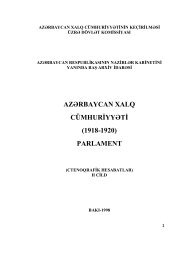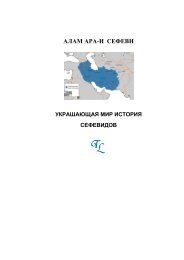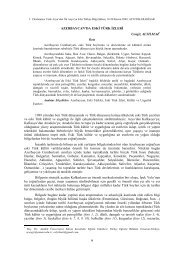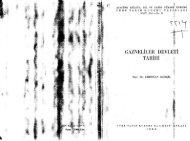War and Peace in Qajar Persia: Implications Past and ... - Oguzlar.az
War and Peace in Qajar Persia: Implications Past and ... - Oguzlar.az
War and Peace in Qajar Persia: Implications Past and ... - Oguzlar.az
- No tags were found...
You also want an ePaper? Increase the reach of your titles
YUMPU automatically turns print PDFs into web optimized ePapers that Google loves.
PrologueThe dream of empirePeter W. AveryThe Safavid dynasty conquered <strong>and</strong> then ruled over most of what today isthe geographical entity, Iran, for 234 years. That the period of the achievementof Safavid sway over Iran is described as hav<strong>in</strong>g been preceded by itsconquest is significant. Dom<strong>in</strong>ion over the whole country was only achievedby the fifth Safavid Shah ‘Abbas I (1587–1629), who moved the capital Q<strong>az</strong>v<strong>in</strong>to Isfahan, mak<strong>in</strong>g this city one of the wonders of the world. Nader Shahestablished Safavid puppets until his own coronation <strong>in</strong> 1736, but it was theAfghans’ 1722 <strong>in</strong>vasion that <strong>in</strong> fact ended the great regime of the SafavidShahs, which they had formed as a Shi’ite counterpoise to the SunniOttoman Empire.Nader Shah’s Afsharid dynasty lasted from 1736 to his assass<strong>in</strong>ation, bya group of servants considered trustworthy, 11 years later. The dynasty wascarried on through the reign of the bl<strong>in</strong>d Shahrokh who was eventually torturedto death by Agha Mohammad Khan <strong>Qajar</strong> <strong>in</strong> 1796 when the latterwas seek<strong>in</strong>g to get hold of Nader Shah’s treasury.Agha Mohammad Khan <strong>Qajar</strong> was the founder of a dynasty that lasted145 years. In some respects it emulated that of the Safavids, not least <strong>in</strong> successfullyaccomplish<strong>in</strong>g dom<strong>in</strong>ion over the whole of the modern Iranian area.Afghanistan had become detached after the fall of Nader Shah, but, <strong>in</strong>sofaras its city of Herat was concerned, was twice the target of the <strong>Qajar</strong> rulers.Pretensions to prov<strong>in</strong>ces <strong>in</strong> Central Asia had long s<strong>in</strong>ce been dropped;Nader Shah attempted a reconquest there but failed. The expedition planned<strong>in</strong> 1833 by the brilliant <strong>in</strong>novative military reformer, the <strong>Qajar</strong> ‘Abbas Mirza,was aborted by this Pr<strong>in</strong>ce’s untimely death. It was the premature demise ofa man who, had he lived to succeed his father, Fath-Ali Shah, might havecompletely changed the future of Iran.The purpose <strong>in</strong> draw<strong>in</strong>g attention to, first of all, <strong>Qajar</strong> emulation of Safavidrule <strong>and</strong>, secondly, the length of time their respective dynasties survived,becomes manifest when the state of Iran which the <strong>Qajar</strong>s found <strong>and</strong>, forthat matter, which the Safavids had found on their ascent to power, is notedas hav<strong>in</strong>g been a scene of anarchy. On the murder of Nader Shah, his hugeWehrmacht fell apart. His Afghan general, Azad, took over Azerbaijan. HisBakhtian Officer, Mardan Khan, held Isfahan, while Karim Khan Z<strong>and</strong> reigned


